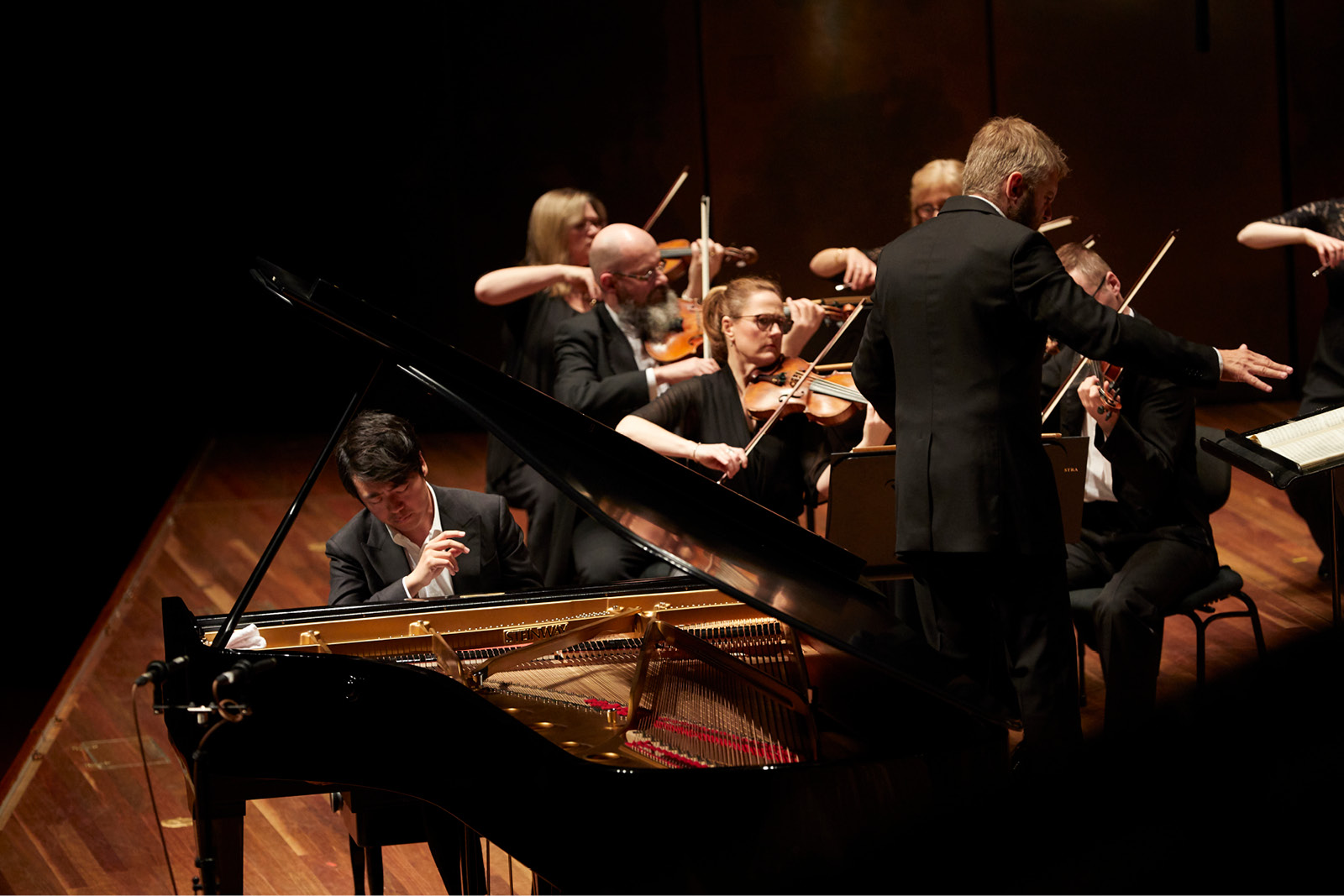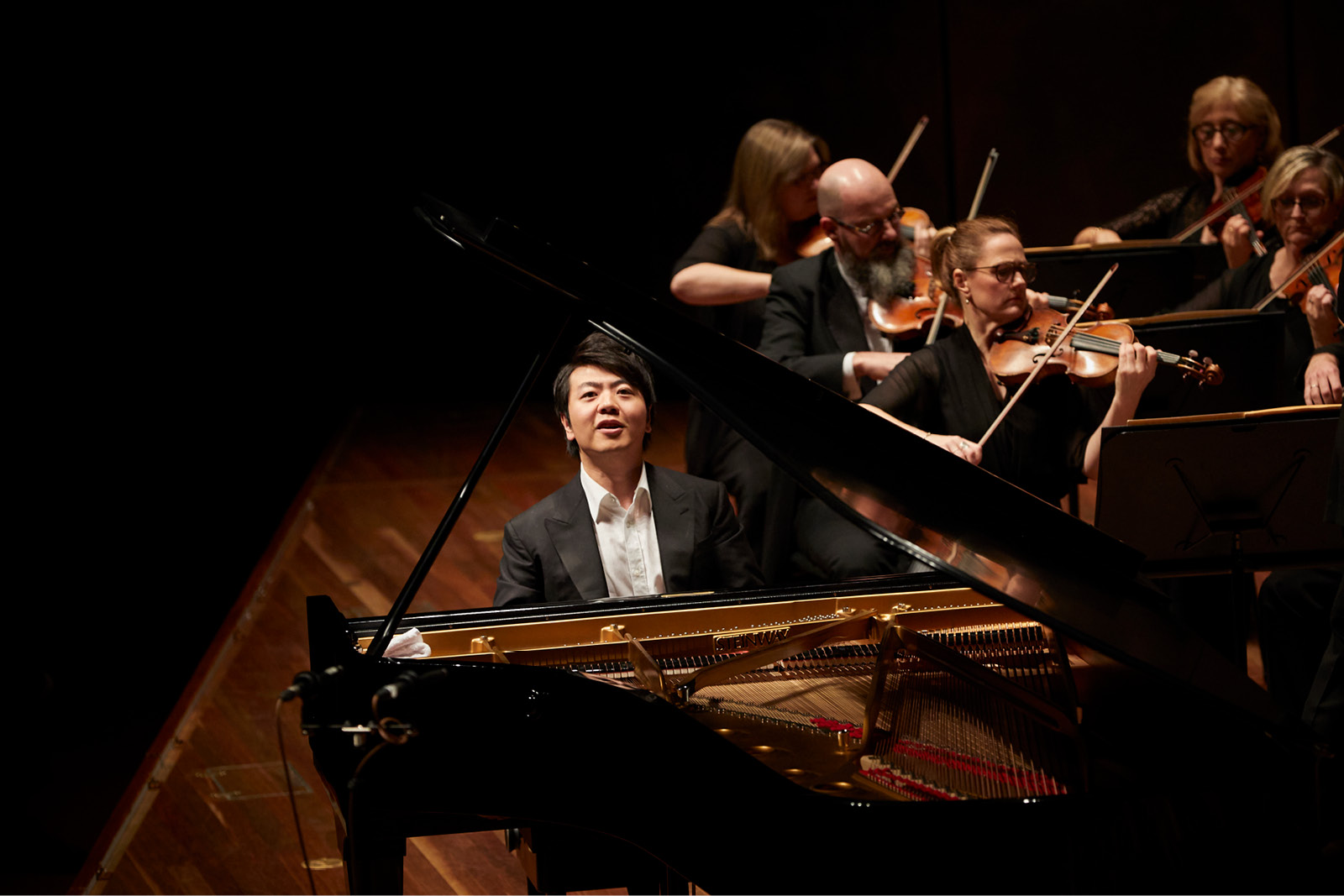Is there a better upbeat curtain-raiser than Mozart’s The Marriage of Figaro Overture? Clocking in at just five minutes, the mood is set for this naughty bedroom farce of class straight away. Being chucked out of the priesthood for adultery, and as a close friend of Casanova’s, the librettist Lorenzo Da Ponte was surely well-qualified to deal with the mad comings and goings of the opera’s plot.
 Lang Lang, Kirill Karabits and the Melbourne Symphony Orchestra. Photo © Laura Manariti
Lang Lang, Kirill Karabits and the Melbourne Symphony Orchestra. Photo © Laura Manariti
The style of playing adopted by conductor Kirill Karabits for this performance was not your lean and mean ACO approach, but a more old-fashioned style, which left room for some elegance.
Written at the same time as Figaro but never published in his lifetime, Mozart’s Piano Concerto No 24, K.491 is one of only two in a minor key. Once again, the opening bars lure you into a tone of impending terror, though it is more a character of sorrowfulness that pervades the rest of the concerto. In the original manuscript of this despairing music, Mozart, true to form, still managed to draw some funny faces over what was probably a botched ‘repeat sign’. In the usual three movements, the finale in particular is full of seemingly endless new ideas.
Speaking of which, the late conductor Nikolaus Harnoncourt noted that pianist Lang Lang was especially ‘open minded’ when they recorded this concerto together in 2014. Though the difference between ‘open minded’ and just plain ‘empty headed’ can be slim, there is something childlike and adorable about Lang Lang that is mesmerising, and it appears to be absolutely genuine.
 Lang Lang and the Melbourne Symphony Orchestra. Photo © Laura Manariti
Lang Lang and the Melbourne Symphony Orchestra. Photo © Laura Manariti
His playing is sometimes wayward but never boring. I love his improvisatory style, but it sometimes lacks the logic and intellectual rigour that other players, especially good forte-pianists can bring. The combination of a vivid imagination plus intense historical research can yield interpretations that have an even greater air of truth and authenticity about them, and for me that’s what was missing.
On the plus side, it is wonderful to see someone so totally in command of their instrument. With a gorgeous tone, he is able to draw a pianissimo of sublime subtlety from the piano at any given moment, and change the character of his playing on a dime.
Lang Lang has returned to playing after a break due to tendonitis from too much practising. Inevitably, with someone as famous and successful as he is, the concert is going to be more about him than Mozart, and if you can accept that, you probably would have enjoyed the performance.
What champions Rachmaninov had in Leopold Stokowski and the Philadelphia Orchestra. Not only did they give the American premiere of his cantata The Bells, but the world premieres of the Fourth Piano Concerto, Three Russian Folksongs and this evening’s Third Symphony. After Stokowski moved on, Eugene Ormandy and the orchestra premiered his last great work, the Symphonic Dances.
Part of a final flourish of works (including the ‘Paganini Rhapsody’ the previous year) Rachmaninov began his Third Symphony near Lake Lucerne, Switzerland in 1935. Completion was delayed by concert appearances, but it was premiered in November the following year.
Some commentators have suggested that it is full of bitterness, but I don’t hear that. True, it doesn’t have as many sweeping melodies as the more popular Second Symphony written nearly 30 years before, but I think it is just a more complex work that takes a little longer to appreciate. It is in a concise three movements – the Scherzo contained within the slow second movement.
The lithe and energetic conductor Kirill Karabits was part of what was affectionately called ‘a Russian/Ukrainian musical invasion’ in the UK some years ago, when all at once so many of the major orchestras had either Russian or Ukrainian conductors at the helm. There was Gergiev at the LSO, Jurowski at the London Philharmonic, Petrenko in Liverpool, and Karabits in Bournemouth, not to mention Ilan Volkov at the BBC Scottish in Glasgow, who although Israeli-born was of Ukrainian descent. As far as one can tell, they were all very successful.
After a slightly shaky start, Karabits launched into the Allegro moderato with gusto. He clearly loves this music, and was able to convey that love to the orchestra very convincingly, bringing out Rachmaninov’s feelings of homesickness and longing. On a purely technical level, this was an almost perfect performance. It was also one of the most rhythmically free I’ve ever heard, which is okay, but it sometimes meant that the languorous syncopated accompaniment to the big tunes was not always in synch. The rhythms in this movement’s development though, were absolutely riveting.
The second movement was a wonderful opportunity for individual MSO players to shine, and there were exceptional solos from principal horn, flute, violin and bass clarinet in turn, not to mention the cor anglais and oboe. With lush divided string writing, there is more than a touch of Hollywood about the orchestration, which reminded me of Korngold and Waxman, and even Nelson Riddle. The central ‘march’ section was very exciting and dramatic, and proved that Karabits is equally at home in both slow, expressive and fast, rhythmic music.
The audience was particularly bronchial last night, and it made me wonder whether flu vaccine had run out once again. By the last movement, Karabits could wait no longer for the coughing to subside and ripped into it with great abandon. The rather ‘Waltonesque’ fugue was successfully negotiated, and there is even a Sarabande that appears out of nowhere like an oasis. Karabits has the rare gift of making the music talk and breathe, and after a perky flute solo and a toyland march, brought the Symphony to a blazing conclusion.
Oh, and as far as upbeat curtain-raisers are concerned, how about Glinka’s Russlan and Ludmilla or Bernstein’s Overture to Candide as likely candidates?











Comments
Log in to join the conversation.